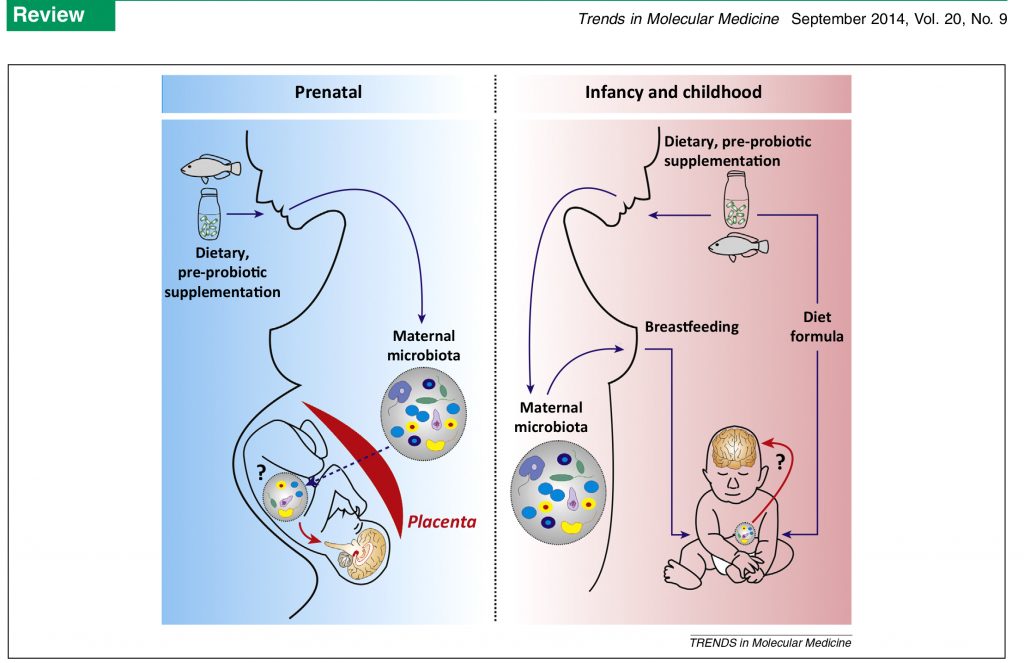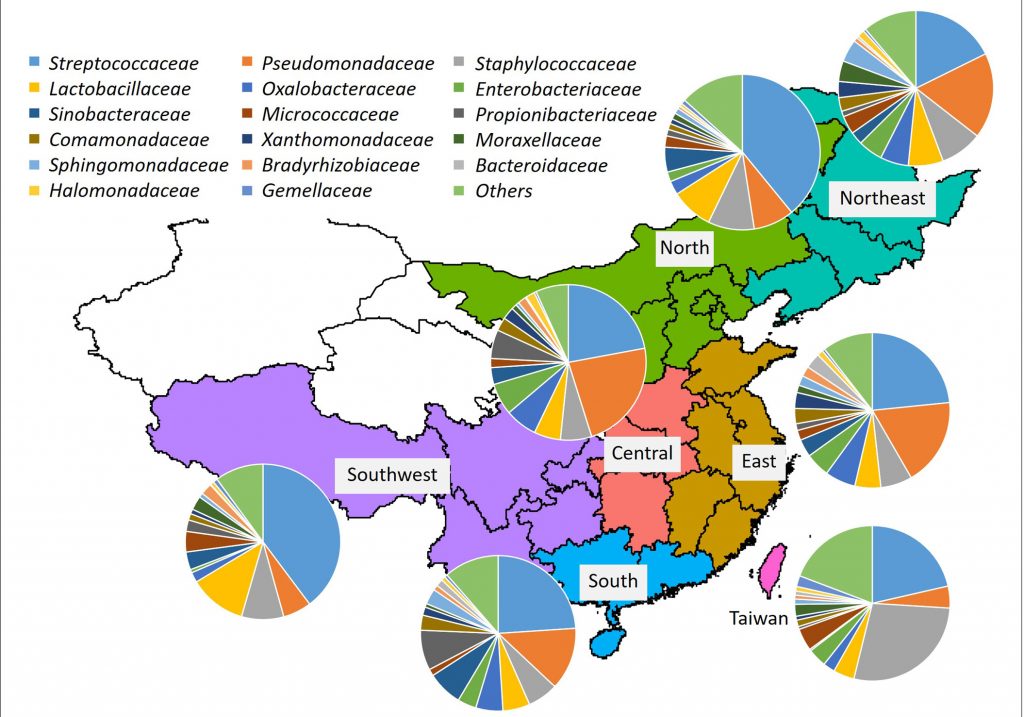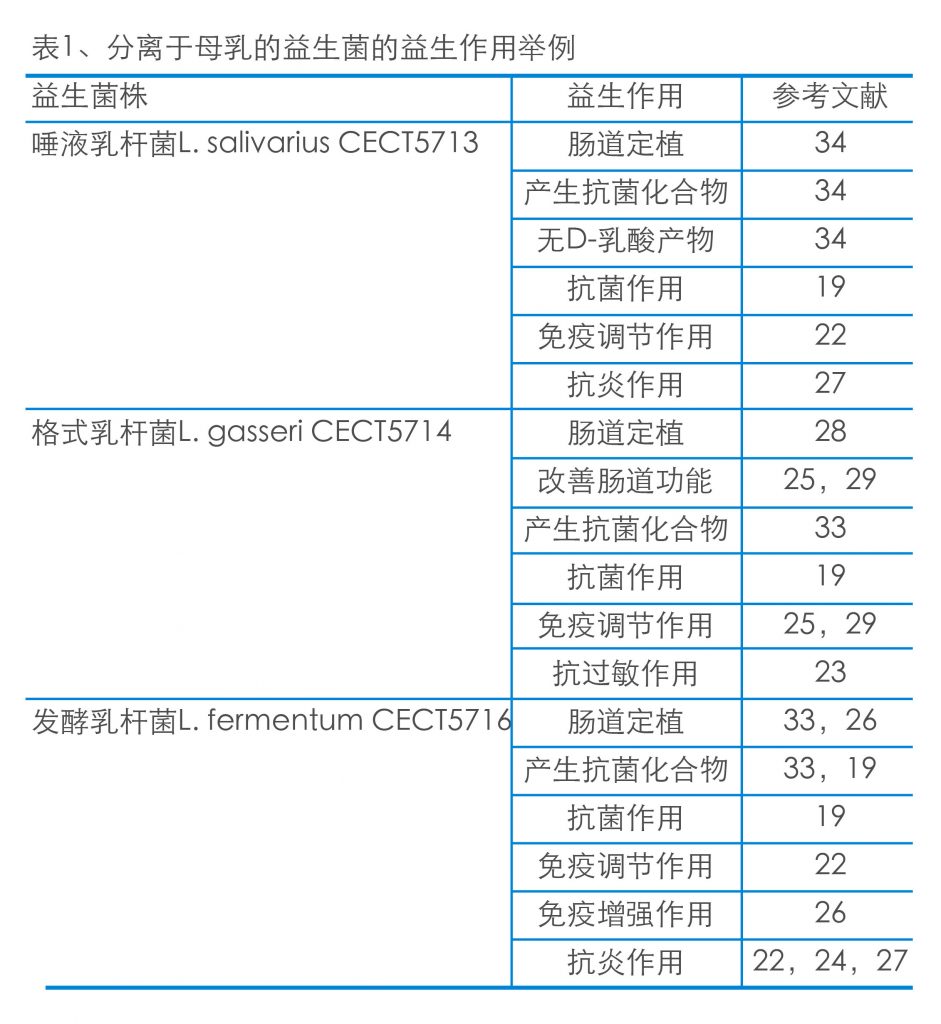学术前沿

走近我们

母乳成分研究

婴幼儿营养健康

儿童营养健康

孕产妇营养健康

实用工具

母乳中益生菌的种类、来源机理和功效
母乳含有微生物这个事实被忽略几十年,如今婴配粉中添加母乳源益生菌已是趋势
母乳是完全满足新生儿营养和免疫需要的具有复杂成分的物质,一口母乳中的微生物含量高达百万,与配方奶喂养的婴儿相比,母乳喂养的婴儿各种传染病的发病率显著降低[1-3]。从最早1969年的研究到2017不断有研究团队自母乳中分离取得具有益生特性且对婴儿有益的微生物[4-12]。

近年来兴起的母乳菌研究已清楚地表明母乳中存在近千种微生物,以链球菌、葡萄球菌为主[13]。2015年的研究指出中国妈妈母乳中的微生物主要隶属于变形菌门(Proteobacteria)、硬壁菌门(Firmicutes)、放线菌门(Actinobacteria)和拟杆菌门(Bacteroidetes),含量约占序列总数的99.55%[9]。在分类学属的水平上,初乳和成熟乳两种不同类型的母乳核心菌群包括克雷伯氏菌属(Klebsiella)、罗尔斯通菌属(Ralstonia)、金黄杆菌属(Chryseobacterium)、鞘氨醇单胞菌属(Sphingomonas)、水栖菌属(Enhydrobacter)、寡养单胞菌属(Stenotrophomonas)、沙雷氏菌属(Serratia)、肠杆菌属(Enterobacter)、假单胞菌属(Pseudomonas)、链球菌属(Streptococcus)、葡萄球菌属(Staphylococcus)和不动杆菌属(Acinetobacter)[12];2017年的研究表明大陆与台湾母乳中相对丰度前五大的菌科分别为链球菌科(24.4%)、假单胞菌科(14.0%)、金黄色葡萄球菌科(12.2%)、乳杆菌科(6.2%)以及草酸杆菌科(4.8%)[11] ,母乳非无菌的概念已广为人认可[14]。

目前母乳中菌群来源机理逐渐清楚,主要是母亲的胃肠道菌群通过肠道和乳房吸吮的反馈通路(Enteromammary pathway),及哺乳期间乳房的细菌暴露组成[15]。母乳中还有一些乳杆菌,如格氏乳杆菌、唾液乳杆菌、鼠李糖乳杆菌、植物乳杆菌和发酵乳杆菌,越来越引起人们的关注。这些菌在降低母乳喂养婴儿传染病的发病率及严重程度方面都具有重要作用[16-33]。根据世界卫生组织定义,益生菌是活的微生物,经适量摄取后对宿主有益。近年研究显示母乳含有微生物且有些菌株具有益生特性。与配方奶粉喂养的新生儿相比,母乳喂养的新生儿还具有更加有益健康的肠道菌群[36]。欧洲的研究团队都分别证实了乳酸菌在母乳中的存在和它们的益生潜能[30]。Heikkila等人报告指出,这些母乳中的微生物可以保护母亲和新生儿免于葡萄球菌引起的感染。之后有一系列类似的报道,Martin等人[31]描述了分离于母乳的乳酸菌,即格氏乳杆菌CECT5714[33],唾液乳杆菌CECT5713[34]和发酵乳杆菌CECT5716[33]。其益生作用见下表1。其中发酵乳杆菌Lactobacillus fermentumCECT5716,分离自健康母乳,今年已列入婴配粉食用菌株名单中。母乳益生菌的进一步研究,能引导我们开发更接近母乳的配方,因此当不能进行母乳喂养时,或可尝试添加母乳源的益生菌婴配奶粉,提供新生儿家庭新选择。

参考文献
[1]Lopez-Alarcon M, Villalpando S, Fajardo A. Breastfeeding lowers the frequency and duration of acute respiratory infection and diarrhea in infants under six months of age. Nutr, 1997, 127: 436-443
[2]Wright AL, Bauer M, Naylor A, et al. Increasing breastfeeding rates to reduce infant illness at the community level. Pediatrics, 1998, 101: 837-844
[3]Microbiota and neurodevelopmental windows: implications for braindisordersYuliya E. Borre1, Gerard W. O’Keeffe, Gerard Clarke, Catherine Stanton, Timothy G. Dinan, and John F. Cryan Trends in Molecular Medicine, 2014, 20:509-518
[4]Carroll L, Osman M, Davies DP, McNeish AS: Bacteriology of raw breast milk. Lancet 1979, 2:1186.
[5]Eidelman AI, Szilagyi G: Patterns of bacterial colonization of human milk. Obstet Gynecol 1979, 53:550-552.
[6]el-Mohandes AE, Schatz V, Keiser JF, Jackson BJ: Bacterial contaminants of collected and frozen human milk used in an intensive care nursery. Am J Infect Control 1993, 21:226-230.
[7]Wyatt RG, Mata LJ: Bacteria in colostrum and milk of Guatemalan Indian women. J Trop Pediatr 1969, 15:159-162.
[8]Thomsen AC, Hansen KB, Moller BR: Leukocyte counts and microbiologic cultivation in the diagnosis of puerperal mastitis. Am J Obstet Gynecol 1983, 146:938-941
[9]杨晓燕,胡艳玲,陈超,唐军,赵静,母得志,转送母乳细菌培养结果的初步分析。中国当代儿科杂志,2015 年,第17期,1333-1337页
[10]席晓霞,黄卫强,张家超,霍冬雪,侯强川,张和平,孙天松。初乳与成熟母乳微生物群落结构研究,2015年,第十届乳酸菌与健康国际研讨会的资料
[11]Shiao-Wen Li, Koichi Watanabe, Chih-Chieh Hsu, Shiou-Huei Chao, Zheng-Hua Yang, Yan-Jun Lin, Chun-Chiang Chen, Yong-Mei Cao, Hsuan-Cheng Huang, Chuan-Hsiung Chang and Ying-Chieh Tsai. Bacterial Composition and Diversity in Breast Milk Samples from Mothers Living in Taiwan and Mainland China. 2017, 8:965
[12]Mohammadi, F., Eshaghi, M., Razavi, S., Sarokhalil, D. D., Talebi, M., & Pourshafie, M. R. Characterization of bacteriocin production in Lactobacillus isolated from mother’s milk. Microbial Pathogenesis 2018; 118, 242–246.
[13]彭文静,曹云。母乳微生态及其研究进展。中华围产医学杂志,2018年第7期,483-486页
[14]McGuire MK, McGuire MA: Human milk: mother nature’s prototypical probiotic food? Adv Nutr 2015, 6:112-123.
[15]Henrike Bergmann, Juan Miguel Rodr ́ıguez, Seppo Salminen and Hania Szajewska. Probiotics in human milk and probiotic supplementation in infant nutrition: a workshop report. British Journal of Nutrition 2014, 112:1119–1128
[16]Kalliomaki M, Salminen S, Arvilommi H, et al. Probiotics in primary prevention of atopic disease: a randomized placebo-controlled trial. Lancet, 2001, 357(9262): 1076-1079
[17]Hoyos AB. Reduced incidence of necrotizing enterocolitis associated with enteral administration of Lactobacillus acidophilusand Bifidobacterium infantisto neonates in an intensive care unit. Int J Infect Dis, 1999, 3(4): 197-202
[18]Fons M, Gomez A, Karjalainen T. Mechanisms of colonization and colonization resistance of the digestive tract. Microb Ecol Health Dis, 2000, 12: 240-246
[19]Olivares M, Diaz-Ropero MP, Martin R, et al. Antimicrobial potential of four lactobacillusstrains isolated from breast milk. J Appl Microbiol, 2006, 101(1): 72-79
[20]Talarico TL, Dobrogosz WJ. Chemical characterization of an antimicrobial substance produced by Lactobacillus reuteri. Antimicrob Agents Chemother, 1989, 33: 674-679
[21]Senok AC, Ismaeel AY, Botta GA. Probiotics: facts and myths. Clin Microb Infect, 2005, 11: 958-966
[22]Diaz-Ropero MP, Martin R, Sierra S, et al. Two Lactobacillus strains, isolated from breast milk, differently modulate the immune response. J Appl Microbiol, 2006, 102: 337-343
[23]Olivares M, Dl’az-Ropero MP, Lara-Villoslada F, et al. Effectiveness of probiotics in allergy: child’s game or adult affair. Nutr foods, 2005: 59-64
[24]Peran L, Sierra S, Comalada M, et al. A comparative study of the preventative effects exerted by two probiotics, Lactobacillusreuteriand Lactobacillus fermentum, in the trinitrobenzenesulfonic acid model of rat colitis. Br J Nutr, 2007, 97: 96-103
[25]Olivares M, Diaz-Ropero MP, Gomez N, et al. The consumption of two new probiotic strains, Lactobacillus gasseriCECT5714 and Lactobacillus coryniformisCECT5711, boost the immune system of healthy adults. Int Microbiol, 2006, 91: 47-52
[26]Olivares M, Dl’az-Ropero MP, Sierra S, et al. Oral intake of Lactobacillus fermentumCECT5716 enhances the effect of influenza vaccination. Nutrition, 2007, 23: 254-260
[27]Peran L, Camuesco D, Comalada M, et al. Preventative effects of a probiotic, Lactobacillus salivariusssp salivarius, in the TNBS model of rat colitis. World J Gastroenterol, 2005, 11: 5185-5192
[28]Olivares M, Dl’az-Ropero MP, Gomez N, et al. Oral administration of two probiotic strains, Lactobacillus gasseriCECT5714 and Lactobacillus coryniformisCECT5711, enhances the intestinal function of healthy adults. In J Microbiol, 2006, 107: 104-111
[29]Lara-Villoslada F, Sierra S, Boza J, et al. Beneficial effects of consumption of a dairy product containing two probiotic strains, Lactobacillus coryniformisCECT5711 and Lactobacillus gasseriCECT5714n in healthy children. Nutr Hosp, 2007, 4: 496-502
[30]Hekkila MP, Saris PEJ. Inhibition of Staphylococcus aureus by the commensal bacteria of human milk. Appl Microbiol, 2003, 95: 471-478
[31]Martin R, Langa S, Reviriego C, et al. Human milk is a source of lactic acid bacteria for the infant gut. Pediatr, 2003, 143: 754-758
[32]Gavin A, Ostovr K. Microbiological characterization of human milk. J Food Prot, 1977: 614-616
[33]Martin R, Olivares M, Marin ML, et al. Probiotic potential of 3 lactobacillistrains isolated from breast milk. Hum Lact, 2005, 21: 8-17
[34]Martin R, Jimenez E, Olivares M, et al. LactobacillussalivariusCECT5713, a potential probiotic strain isolated from infant feces and breast milk of a mother-child pai. Int J Microbiol, 2006, 112: 35-43
[35]Conway PL, Gorbach SL, Goldin BR. Survival of lactic acid bacteria in the human stomach and adhesion to intestinal cells. J Dairy Sci, 1987, 70: 1-12
[36]Harmsen HJM, Wildeboer-Veloo ACM, Raangs GC, et al. Analysis of intestinal flora development in breast-fed infants by using molecular identification and detection methods. Pediatr Gstroenterol Nutr, 2000, 30: 61-67